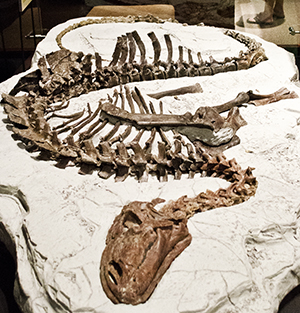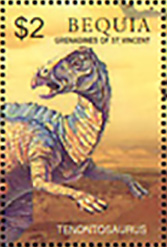Tenontosaurus sp.

(Da: it.wikipedia.org)
Phylum: Chordata Haeckel, 1874
Subphylum: Vertebrata Cuvier, 1812
Classe: Reptilia Laurenti, 1768
Ordine: Neornithischia Cooper 1985
Famiglia: Tenontosauridae
Genere: Tenontosaurus Ostrom, 1970
Specie e sottospecie
Il genere annovera attualmente le seguenti specie: Tenontosaurus tilletti Ostrom, 1970 (specie tipo), caratteristica del Montana, e Tenontosaurus dossi Winkler, Murry & Jacobs, 1997, rinvenuta in Texas e forse appartenente a un genere a sé stante.
Descrizione
L'aspetto di questo animale era piuttosto particolare: di forme pesanti, il Tenontosaurus aveva un'andatura quadrupede. Il collo, piuttosto lungo rispetto a quello di altri ornitopodi, sosteneva un cranio relativamente primitivo. Ma la caratteristica più appariscente dell'animale risiedeva nella coda: muscolosa e lunghissima, sfiorava i 4,5 metri di lunghezza (contro gli 8 totali dell'animale). Non si è ancora capito a cosa servisse una coda così lunga e pesante: una delle ipotesi era che potesse essere utilizzata come "timone" nelle paludi, ma ora si ritiene che Tenontosaurus sia stato un erbivoro completamente terrestre, ed è probabile che la usasse per difendersi dai predatori come Acrocanthosaurus. Fino a qualche tempo fa si pensava che il Tenontosaurus fosse una forma gigantesca di ipsilofodontide, una famiglia di piccoli e agili erbivori vissuta nel Giurassico e nel Cretaceo. Recenti studi, invece, hanno indicato che questo grosso animale era un primitivo iguanodonte, dalle caratteristiche peculiari.
Diffusione
Ritrovato in Nordamerica in strati del Cretacico inferiore.
Bibliografia
–Ostrom, J. H. (1970). "Stratigraphy and paleontology of the Cloverly Formation (Lower Cretaceous) of the Bighorn Basin area, Wyoming and Montana". Bulletin of the Peabody Museum of Natural History. 35: 1-234.
–Winkler, Dale A.; Murry, Phillip A.; Jacobs, Louis L. (1997). "A new species of Tenontosaurus (Dinosauria: Ornithopoda) from the Early Cretaceous of Texas". Journal of Vertebrate Paleontology. 17 (2): 330-348.
–Forster, C. A. (1984). "The paleoecology of the ornithopod dinosaur Tenontosaurus tilletti from the Cloverly Formation, Big Horn Basin of Wyoming and Montana". The Mosasaur. 2: 151-163.
–Forster, Catherine A. (1990). "The postcranial skeleton of the ornithopod dinosaur Tenontosaurus tilletti". Journal of Vertebrate Paleontology. 10 (3): 273-294.
–Paul, Gregory S. (2016). The Princeton Field Guide to Dinosaurs. Princeton University Press. p. 311.
–Campione, N. E.; Evans, D. C. (2020). "The accuracy and precision of body mass estimation in non-avian dinosaurs". Biological Reviews. 95 (6): 1759-1797.
–Butler, R.J.; Barrett, P.M. (2012). "26. Ornithopods". In Brett-Surman, M.K.; Holtz, T.R.; Farlow, J.O. (eds.). The Complete Dinosaur (Life of the Past). Indiana University Press. p. 647.
–Maidment, Susannah; Barrett, Paul (2012-09-21). "Osteological correlates for quadrupedality in ornithischian dinosaurs". Acta Palaeontologica Polonica. 59 (1): 53-70.
–Hunt, Tyler C.; Cifelli, Richard L.; Davies, Kyle L. (2021-07-16). "The hand of Tenontosaurus tilletti (Dinosauria, Ornithopoda)". Journal of Vertebrate Paleontology. 41 (2).
–Bishop, Peter J.; Bates, Karl T.; Allen, Vivian R.; Henderson, Donald M.; Randau, Marcela; Hutchinson, John R. (2020-10-16). "Relationships of mass properties and body proportions to locomotor habit in terrestrial Archosauria". Paleobiology. 46 (4): 550-568.
–Richard J. Butler, Jin Liyong, Chen Jun, Pascal Godefroit (2011). "The postcranial osteology and phylogenetic position of the small ornithischian dinosaur Changchunsaurus parvus from the Quantou Formation (Cretaceous: Aptian-Cenomanian) of Jilin Province, north-eastern China". Palaeontology. 54 (3): 667-683.
–Maxwell, W. D.; Ostrom, J. H. (1995). "Taphonomy and paleobiological implications of Tenontosaurus-Deinonychus associations". Journal of Vertebrate Paleontology. 15 (4): 707-712.
–Dinets, Vladimir (2015). "Apparent coordination and collaboration in cooperatively hunting crocodilians". Ethology Ecology & Evolution. 27 (2): 244-250.
–Roach, B. T.; Brinkman, D. L. (2007). "A reevaluation of cooperative pack hunting and gregariousness in Deinonychus antirrhopus and other nonavian theropod dinosaurs". Bulletin of the Peabody Museum of Natural History. 48 (1): 103-138.
–Brinkman, Daniel L.; Cifelli, Richard L.; Czaplewski, Nicholas J. (1998). "First Occurrence of Deinonychus antirrhopus (Dinosauria: Theropoda) from the Antlers Formation (Lower Cretaceous: Aptain-Albian) of Oklahoma". Oklahoma Geological Survey (164): 1-27.
–D'Emic, Michael D.; Melstrom, Keegan M.; Eddy, Drew R. (2012). "Paleobiology and geographic range of the large-bodied Cretaceous theropod dinosaur Acrocanthosaurus atokensis". Palaeogeography, Palaeoclimatology, Palaeoecology. 333-334: 13-23.
–Lee, Andrew H.; Werning, Sarah (2008). "Sexual maturity in growing dinosaurs does not fit reptilian growth models". Proceedings of the National Academy of Sciences. 105 (2): 582-587.
–Werning, S. (2012). "The Ontogenetic osteohistology of Tenontosaurus tilletti". PLOS ONE. 7 (3) e33539.
–Oreska, Matthew P. J.; Carrano, Matthew T.; Dzikiewicz, Katherine M. (March 2013). "Vertebrate paleontology of the Cloverly Formation (Lower Cretaceous), I: faunal composition, biogeographic relationships, and sampling". Journal of Vertebrate Paleontology. 33 (2): 264-292.
–Wedel, M. J.; Cifelli, R. L. (2005). "Sauroposeidon: Oklahoma's Native Giant" (PDF). Oklahoma Geology Notes. 65 (2): 40-57.
–Weishampel, David B.; Barrett, Paul M.; Coria, Rodolfo A.; Le Loeuff, Jean; Xu Xing; Zhao Xijin; Sahni, Ashok; Gomani, Elizabeth, M.P.; and Noto, Christopher R. (2004). "Dinosaur Distribution", in The Dinosauria (2nd), p. 264.
–Nydam, Randall L.; Cifelli, Richard L. (2002-07-08). "Lizards from the Lower Cretaceous (Aptian–Albian) Antlers and Cloverly Formations". Journal of Vertebrate Paleontology. 22 (2): 286-298.
–Cifelli, Richard L.; Gardner, James D.; Nydam, Randall L.; Brinkman, Daniel L. (August 1997). "Additions to the vertebrate fauna of the Antlers Formation (Lower Cretaceous), southeastern Oklahoma". Oklahoma Geology Notes. 57 (4): 124-131.
–Kielan-Jaworowska, Zofia; Cifelli, Richard L (2001). "Primitive boreosphenidan mammal (?Deltatheroida) from the Early Cretaceous of Oklahoma". Acta Palaeontologica Polonica. 46 (3): 377-391.

|
Data: 01/09/2005
Emissione: Animali preistorici Stato: Bequia Nota: Emesso in un foglietto di 4 v. diversi |
|---|